Andy Edwards is an artist and graphic designer and was also a university lecturer for over 30 years. As a graphic designer, he works with cultural organisations, public bodies and architects. Meanwhile, as an artist, he often uses materials that others have designed, produced, used, and discarded to create mixed media collages.
By elevating detritus and ephemera into artwork in this way, he challenges traditional hierarchies of materials and production values. He enjoys reimagining found material and waste to find accidental juxtapositions that create new meaning within his work. Some of his work is currently in the exhibition ‘Colour From Life’ which is available to view online via The Art Court.
Court Spencer caught up with him in his studio in Leeds.
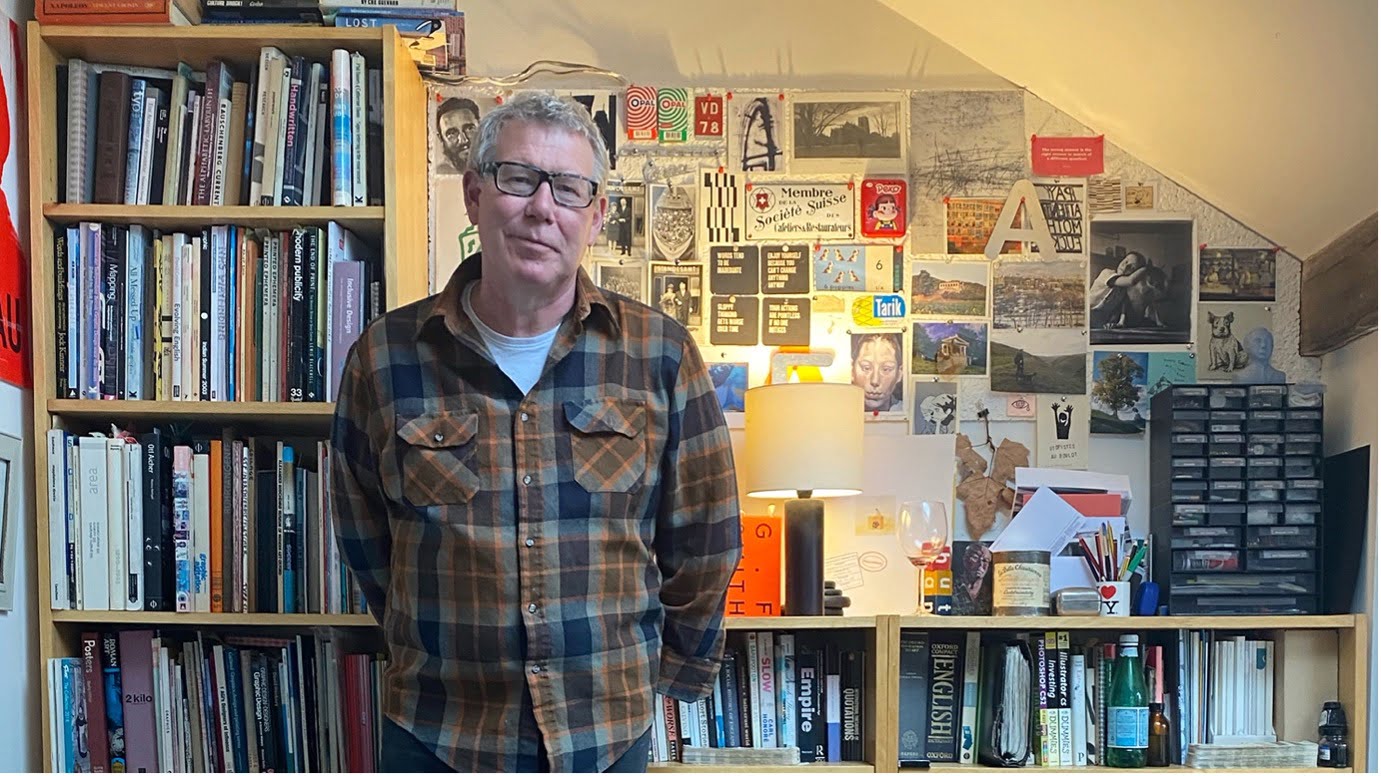
Andy Edwards in his ‘Utility’ studio. (Image credits: Casey Orr)
Court: Thank you so much for having me over. This is great that you’ve got two studio spaces. How long have you been here and do the spaces serve different functions?
Andy: Thanks for coming over and climbing all those stairs to the attic. I’ve been up here since the late 1990s, but only converted the ‘art’ studio 8 years ago. It was a decision to start making work that wasn’t graphic design. My independent art was, and probably still is, the half-starved cousin to my professional design practice! For twenty or so years I had a design studio in Leeds, at Dock Street by the river, but downsized, moving back home. The design work didn’t need all the overheads, so I converted the attic into two distinct spaces – one called ‘utility’ for clean and organised design stuff, the other named ‘futility’ for chaotic art making.
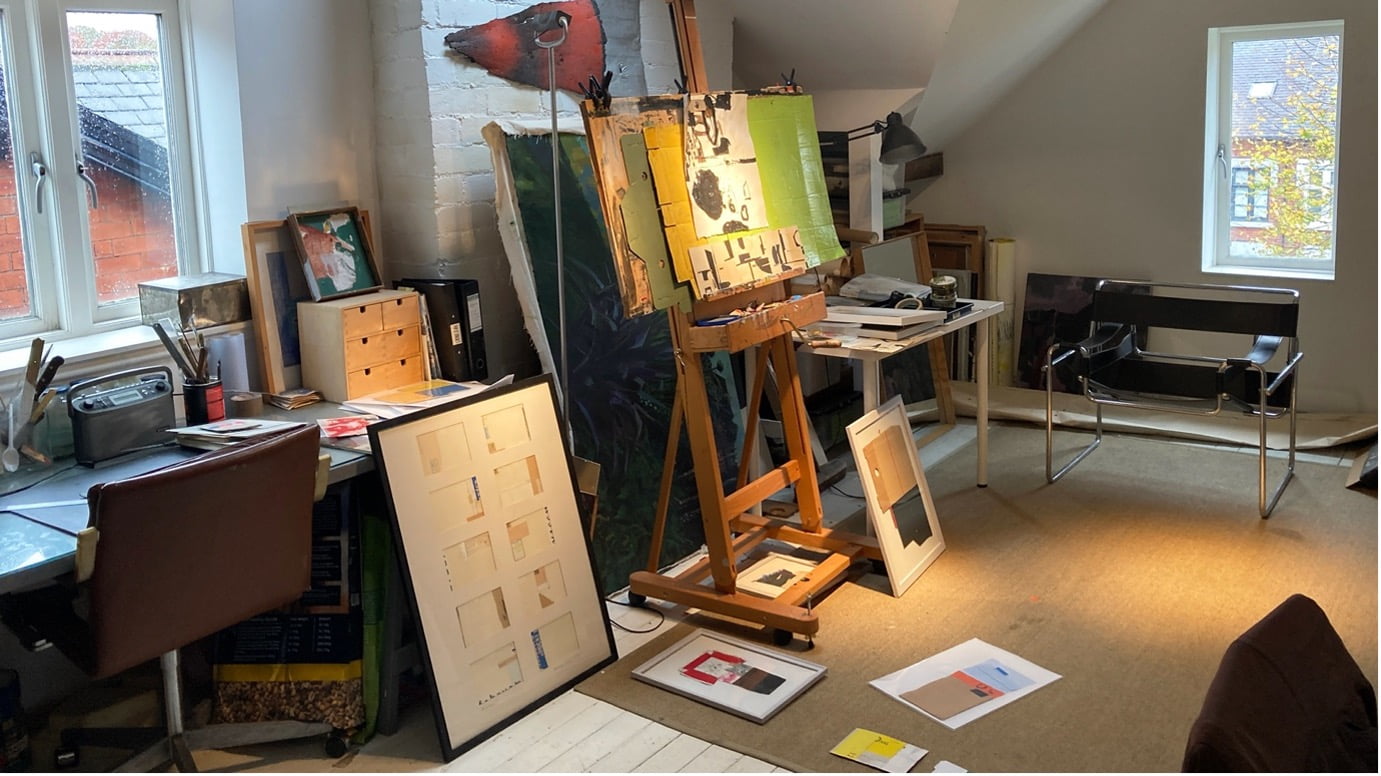
The ‘Futility’ studio.
Court: I like it! That feels like a good way of managing different sections of your brain! When you went to uni was it always the plan to be a graphic designer and graphics lecturer?
Andy: From the age of 16 I knew I wanted to do something around art. I saw a great exhibition at the Hayward in 1979 called ‘Lives’. It mixed up everything; community activism, photography, performance and painting. After that, I designed the school magazine in a kind of punk Buzzcocky way, and at university made posters for Rock Against Racism and CND using photomontage inspired by John Heartfield. I didn’t know this was called ‘Graphic Design’, it just felt like a natural adjunct to making art.
Lecturing wasn’t a career plan, but it became symbiotic to my design practice. I had lecturing jobs first in Hull, then in Leeds. Trips from Hull exposed me to the amazingly adventurous work happening in Holland. Working as a designer or artist can be quite isolated, so I’ve always loved the educational experience.
Court: After graduating what sort of jobs did you do?
Andy: I could draw ‘well’ so I got a job as a visualiser in a design agency in Geneva, where I’d grown up. I’d finished a Fine Art degree at Leeds Uni, and they assumed I’d done graphics. I hadn’t a clue how to typeset or artwork things for print, so during my lunch breaks I’d learn how to do it. This was five years before the Mac knocked out all of those skills; the Swiss experience really set me up.
I ended up back in Leeds because of a relationship. My ‘swiss-style’ letterhead helped me get an invite to do part-time lecturing, even though I’d misspelt ‘stationery’ as ‘stationary’. In the 1980s I also worked as a sign writer, fabric designer, illustrator and picture framer at Impressions Gallery in York. The design scene in Leeds was pretty dire, so I set up an independent design company in 1989, more in hope than with a business plan.
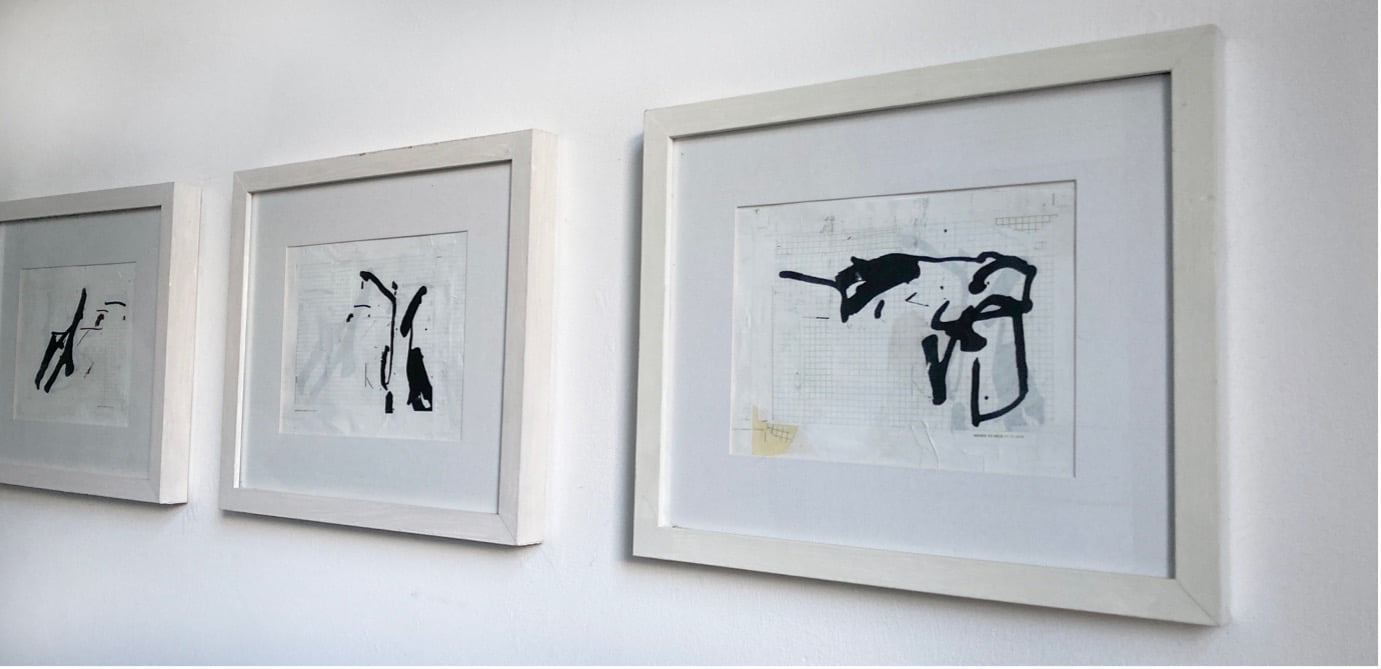
A series of works made during a walk to Keld.
Court: More hope than a business plan might make the world a better place! What brought you to collage as a medium? Are there any people or places that inspired your collages?
Andy: I remember seeing some Hannah Hoch and Kurt Schwitters collages in a small exhibition as a teenager. I thought they were fantastic. Then I saw what Cy Twombly and Bob Rauschenberg were doing on a bigger scale. It’s not that I’m prioritising or championing ‘collage’ as a distinct area of art-making; it’s more that it allows juxtapositions and accidents to happen in a way a lot of ‘pure’ painting doesn’t. The textures are authentic because they’re intrinsic to discarded rubbish.
I do paint, the first exhibition I had at Left Bank when you were there was inspired not by the paintings themselves but by the residual marks left on paper that was protecting the table! I thought these incidental marks were often more interesting than the paintings, so they formed the basis for a series called ‘Dirty Paintings’ which mixed up collage, printing and painting.
In terms of places, I spend a lot of time walking the Dales in all seasons. Landscape and light shift dramatically, especially in winter. So I’ve always made paintings and sketches either out walking or once back home. Most are abstract, some representations of a valley in the rain, for example. One series (pictured above) is little more than calligraphic marks in ink made during a walk to Keld from Muker.
Court: You’ve got a way of seeing the potential of materials that many would overlook. Have you always been someone to look down at the pavement and see details?
Andy: Absolutely! Eyes down! I have what I call ‘lobster pots’… places where you often find things. One of my most cherished possessions is a scuffed-up pink luggage tag I found at Port Authority Bus terminal in New York City when I was 16. It simply reads ‘New York New York’ on two lines. I like making work that draws on incidental, urban visual mess: traces of old sellotape left to collect dust on a noticeboard, overpainted graffiti, marker-pen tags, scuffs and scrapes. ‘…the muddy stream of being’ as Herman Hess put it in Steppenwolf.
Though they’re on canvas, I really like Joe Bradley’s huge paintings; they seem to share the same dirty disregard for ‘taste’. There’s a big canvas of his in the public area of MoMa. It looks like a mucky candy wrapper has blown in uninvited and stuck itself to the wall.
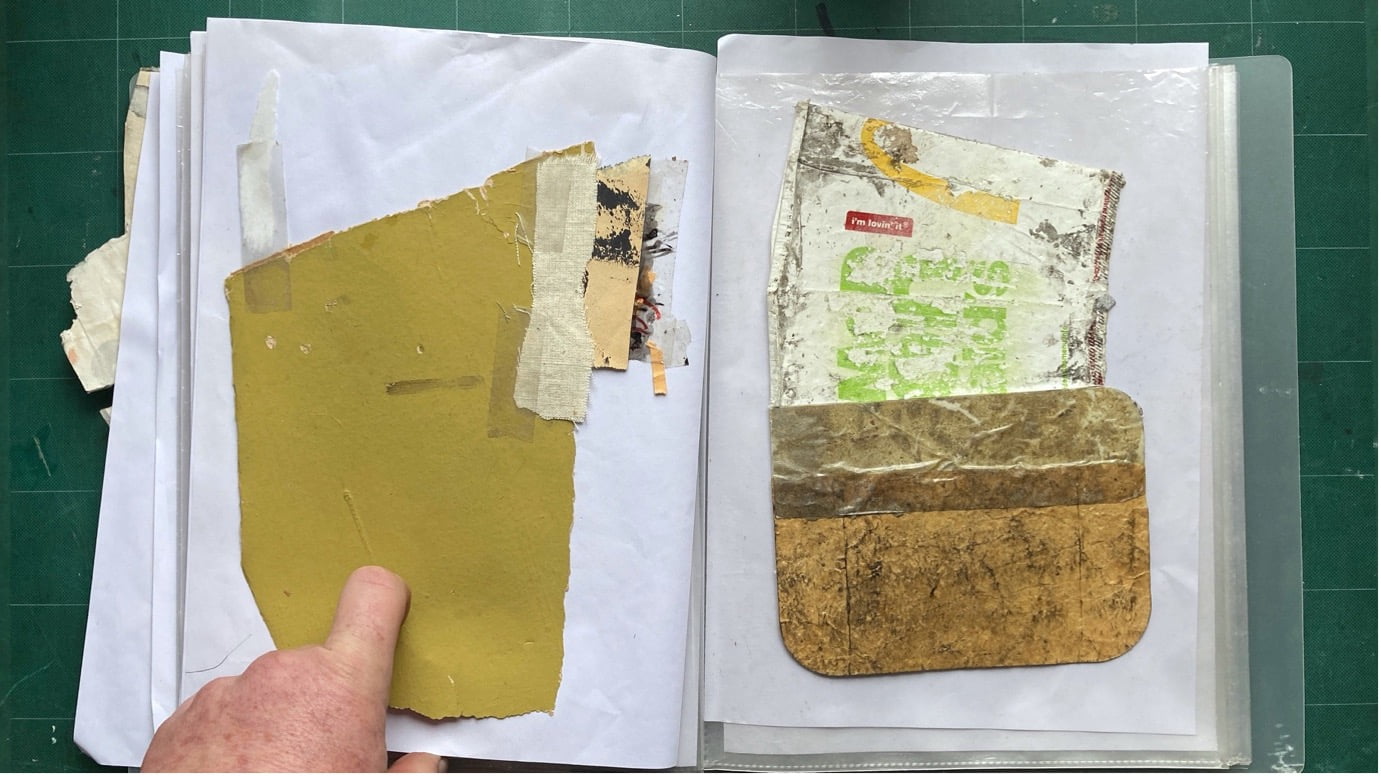
Collages in progress.
Court: I know you have mentioned that you see many of your collages as studies for bigger works. Now that you’re no longer working as a lecturer is the plan to spend more time on this sort of work?
Andy: Yes. Certainly. The ‘Futility’ studio is being redesigned in a new house we’re moving to so I can work on four or five larger pieces together. I’ll still work with elements of collage, but I also want to explore combining some of the more commercial processes I’ve used as a designer: laser cut vinyl and stencils, powder-coating, and screenprint; all mixed up with hand-painted areas.
The smaller compositions on paper would be a starting point; to try and hold on to the strengths of asymmetry or composition when scaled up. I’ve talked with a Leeds laser-cutting factory I’ve worked with for years on commercial jobs about doing a residency with them. The ‘brief’ is to use waste cut steel as stencils to spray whatever colour they happen to be powder coating with that day: it’s about working large and quickly, but also having constraints. Don Judd used commercial aluminium box making and powder coating in his work. The image on the far right of the ‘Dirty Paintings’ photo (below) is an example of this idea.
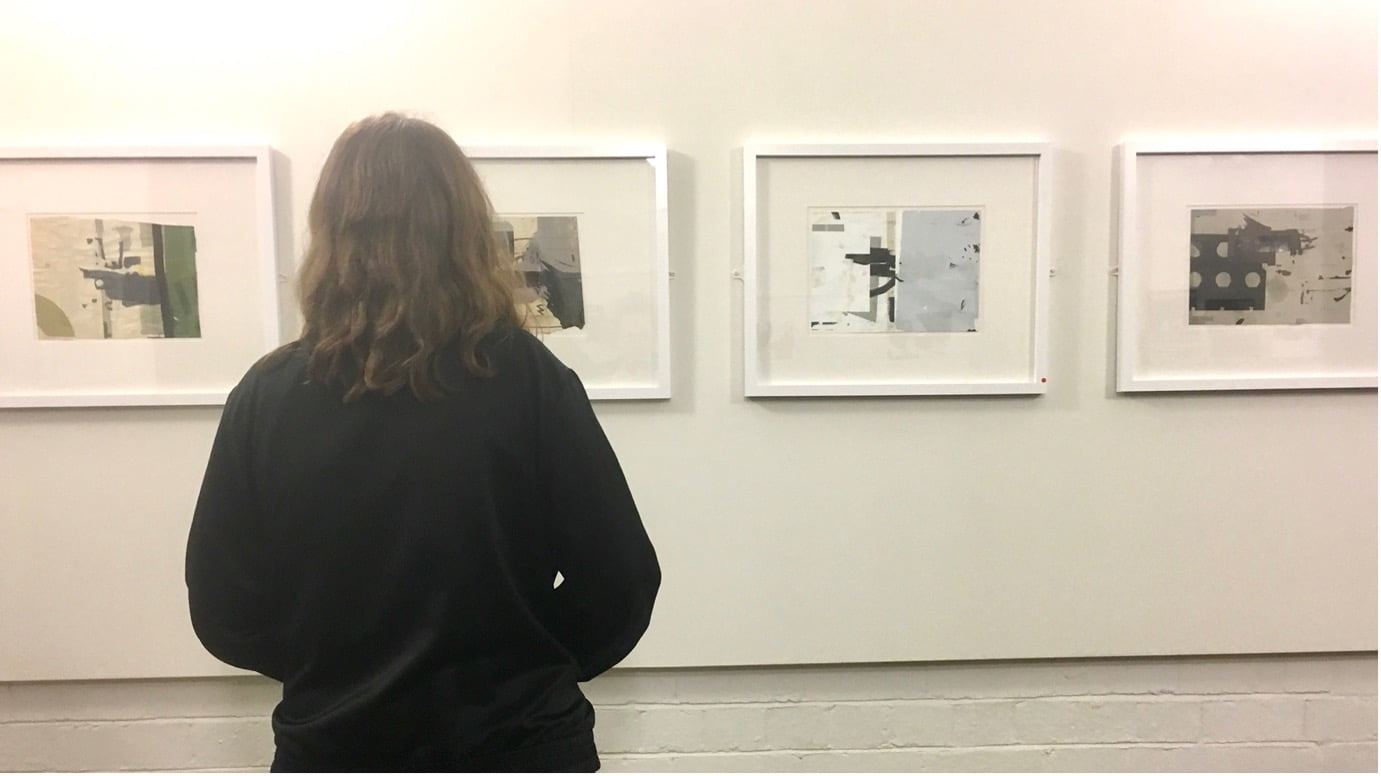
Exhibition view of ‘Dirty Paintings’ at Left Bank Leeds in 2017.
Court: Si Smith has curated two brilliant exhibitions with your work, one at Left Bank Leeds and more recently at Lidget Lane Larder in Leeds and was so pleased to include your work in the exhibition ‘Colours From Life’. With your design work, you’re working to someone else’s brief and deadline. How do you find working on your own art? And do you enjoy exhibiting?
Andy: I’m really delighted to be asked to part of your ‘Colours from Life’ exhibition. If I remember correctly Si Smith had commissioned some ‘straight’ design work off me, and stumbled on the more private ‘art’ side of my work. ‘Dirty Paintings’ forced me to make explicit the themes I’ve been working with since my teens. These revolve around ideas of beauty and imperfection, the found and the made. It’s so helpful to show work, to get feedback, to know people who bought pictures are enjoying them and even understand them.
Design briefs have limitations. My experience is that there’s less appetite to take risks now, with user experience and audience feedback heavily informing design decisions. But some of the restrictions set by a brief are helpful when you’re making art or collages; setting a few rules prevents aimless speculation. I made a group of collages you saw at Lidgett Lane Larder called ‘D–Livery’. They all riffed on a restricted palette of the livery colours of delivery companies that sprung up during lockdown. Deliveroo green, UPS brown and yellow.
Exhibiting art for the first time was about revealing something I’ve struggled with since I graduated. I chose to do Fine Art at Leeds University because it was a radical, Marxist-feminist Course back in the 80s. Our work was a critique of gallery-based, individualised ‘heroics’. Instead, we made video and photography, mostly accompanied by dense theoretical texts. But throughout all this, I held on to a secret passion for some of the formalism that got me into art— Frankenthaler, Motherwell, Schwitters, Ivon Hitchens and many more. So yes, I enjoy exhibiting. It has been a kind of aesthetic ‘coming out’.
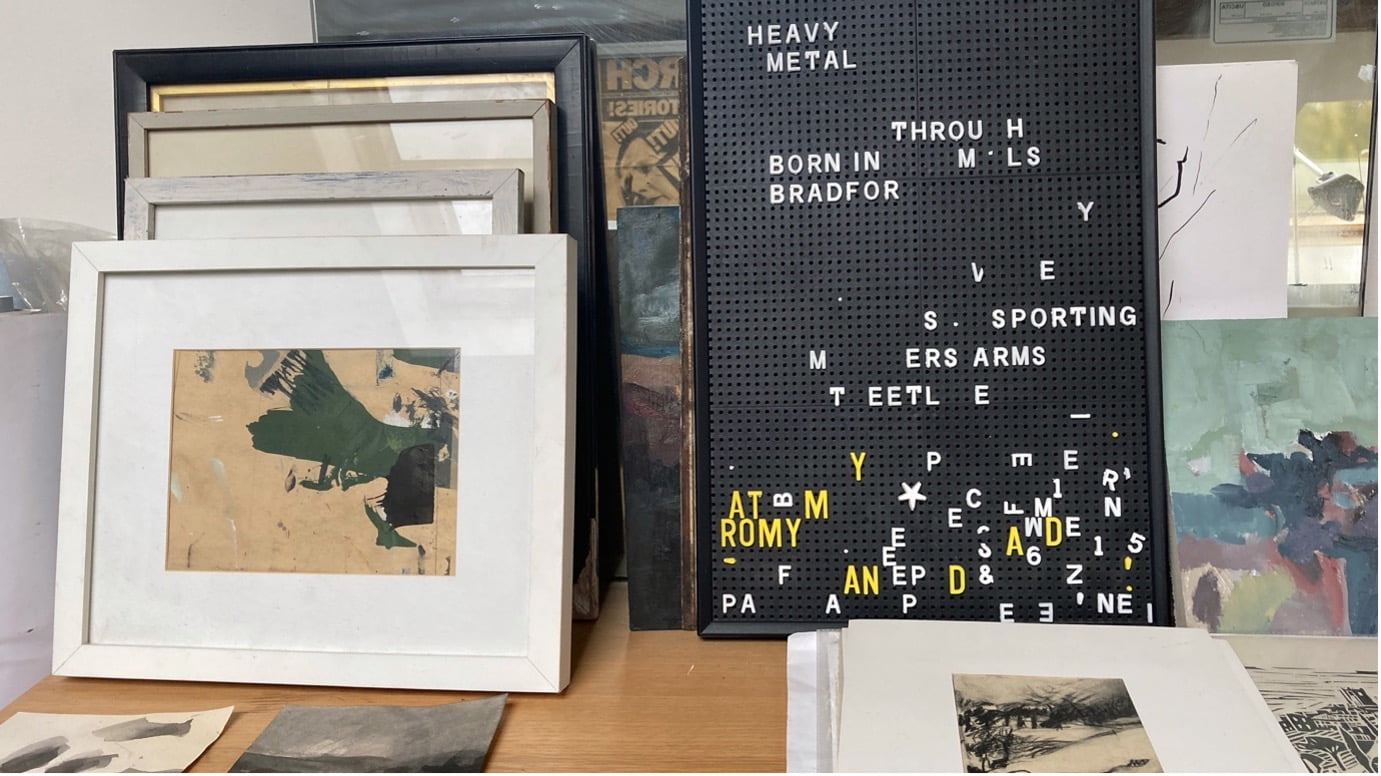
A piece from the ‘Dirty Paintings’ series alongside signage used on a current typographic project.
Court: I know what you mean. It can feel quite revealing in a way and it takes courage to share that. What are you working on at the moment?
Andy: With a new book project due to start early February I’ve got space to make some new work. I’ve made a series of A5-ish black and white collages which are very loosely informed by Beesley’s photos of post-industrial heritage and landscape in West Yorkshire. Lots of verticals, possibly chimneys, and horizontal blocks. The plan is to project them on to salvaged wood, carve them, making roughly A0 scale woodcut prints. As a priority I’ve also got to sort out my online profile too!
Court: Well that all sounds very exciting, even the online profile! What would you say is your career highlight to date? It can be across art or design.
Andy: A near impossible question. The answer is ‘the career’. I’m chuffed to wake up and be excited to work doing something that isn’t alienating or remote, something that seldom feels certain. I chose not to practice in retail or commercial sectors so I’ve seen the real social impact of some of the design projects we worked on, be it for Bradford Hospitals or an Irish housing and welfare charity in Leeds. We’ve designed identities still used today, like Yorkshire Sculpture Park (YSP). But the project I’d pick as a highlight was designing work (remove ‘work’) for Leeds International Film Festival from 1990 for maybe 8 years. We made large-scale installations, often surreal, to be photographed for posters. This was long before Photoshop. The 1993 shot involved turfing an entire upper floor of an office block in the city centre and allowing sheep to graze on it. The Festival director was completely up for it, and those bits of work meant I got opportunities to work with other people who’d seen our approach: Leeds Playhouse, Pheonix Dance, Impressions or YSP.
As a direct result of this work I also met Bauman Lyons Architects. This led to a decades old relationship of publishing, wayfinding, public typography and branding. It also included an amazing environmental art project in the Neville Street underpass under Leeds railway station. A two year collaborative project using dark anodised, perforated aluminum that the Berlin-based artist Hans Peter Kuhn designed the east wall and I designed the west side (pictured below). Sadly, this has just been decommissioned.
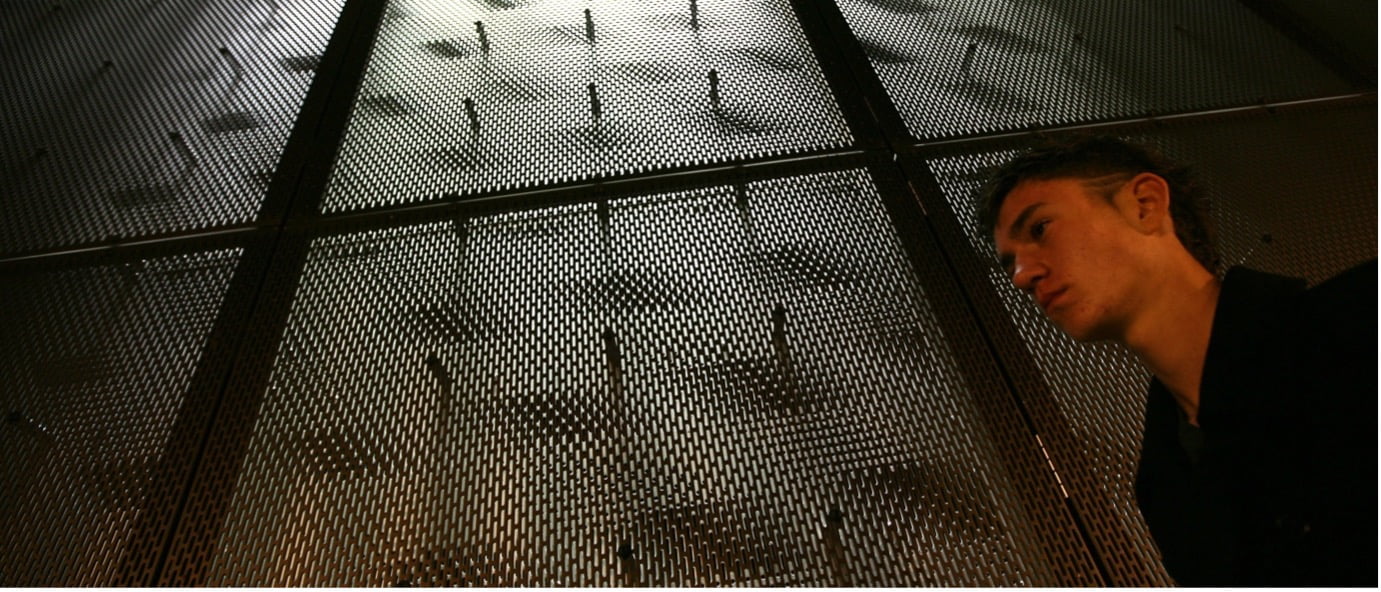
‘Light’ the wall on Neville Street by Andy Edwards. (Image credits: Kippa Matthews)
Court: Do you have a dream project or something you would love to make happen?
Andy: My own ambition would be to work at that metal engineering and laser cutting factory in South Leeds for a few months and see what happens. Hopefully it’ll be good enough to show, and there’d be someone willing to show it. I’m also planning a long-distance collaboration with my good friend and artist Natalie Woolf who works in Lisbon. The idea is to each mix the same RAL paint colours and then use the randomness of playing ‘Battleships’ to determine the paintings.
Court: 2024 is the year for these! If people were interested in following your work, what’s the best way for them to do that? Website, Instagram etc?
Andy: I’m ashamed to say not. I’ve got an Instagram account, but haven’t populated it yet. Moving house has pushed everything back, but I’ll have a website and Instagram sorted by the start of 2024, I hope.
Court: Brill! You’ve got such an incredible archive of projects to share on Instragram, and of course loads of new things coming too. I know so many people would be interested in following your work. Thanks again for your time.
Filed under: Art & Photography

Comments